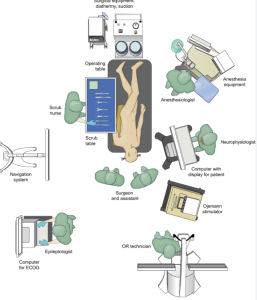In a retrospective observational study Zigiotto et al. from the S. Chiara University-Hospital, Azienda Provinciale per i Servizi Sanitari, Trento, published in the Neurosurgery Journal on 64 glioma patients who underwent awake surgery (AwS) or asleep surgery (AsS), with neuropsychological and imaging follow-up. They evaluated the impact of awake surgery on attentional outcomes in glioma patients, and analyzed whether greater extent of tumor resection correlates with transient cognitive (attentional) decline, especially in relation to lesions within the default mode network. Awake surgery allows for more extensive supramaximal resection and is associated with longer overall survival, particularly in patients with glioblastomas. However, it also leads to a higher rate of transient postoperative attentional dysfunction, likely due to resection in attention-related brain networks. The study suggests that patient selection and intraoperative cognitive monitoring should be optimized in future glioma surgery 5).
This retrospective study compares awake versus asleep craniotomy in 64 glioma patients, using simple attention tests before and after surgery. The authors claim that awake craniotomy (AwC) allows more extensive tumor resection and leads to longer survival, albeit at the cost of transient attentional dysfunction.
🧠 1. Conceptual Inflation Meets Methodological Reductionism
The title promises a nuanced exploration of cognitive outcomes. What it delivers is a reduction of “attention” to the Trail Making Test Part A and a visual search task — an embarrassingly narrow lens for such a multidimensional construct. The study purports to evaluate the impact of surgery on attention, yet fails to define attention, stratify its subtypes, or provide any neuropsychological depth. This is not a cognitive study — it’s a surgical paper pretending to be one.
📉 2. Supramaximal Resection: A Buzzword Without a Backbone
The authors repeatedly refer to “supramaximal resection” as a virtue of AwC. However, their criteria for this designation remain vague, lacking reproducible thresholds or clear oncological benchmarks. In the absence of molecular stratification beyond IDH status, this term becomes an exercise in surgical vanity, not science.
The survival difference observed in IDH-wildtype glioblastoma is interesting but likely confounded by patient selection bias, preoperative status, and extent of resection — all poorly controlled in this retrospective, underpowered dataset.
🎭 3. Attentional Dysfunction: A Passing Glitch or a Glossed-Over Harm?
The authors downplay postoperative attentional dysfunction as “transient,” based on a 1-month follow-up — an arbitrarily short window in neuro-oncology. There’s no follow-up at 3 or 6 months, no correlation with functional recovery or quality of life, and no assessment of whether deficits return with adjuvant therapy. This is not transience — it’s truncation.
📚 4. Academic Camouflage and Citation Padding
The paper includes 81 references but suffers from academic echo chamber syndrome. The authors avoid engaging with conflicting evidence, omit any mention of failed AwC outcomes, and never reference neuropsychology literature beyond superficial tools. This is surgical tunnel vision at its finest: cut more, assume better, test little.
🚨 5. Takeaway Message: Beware the Unmapped Mind
This paper is a cautionary tale about the hubris of maximalism in brain surgery. It seeks to validate more aggressive resections by anesthetizing its readers with promises of transient dysfunction and longer life — without the methodological rigor to justify either.
The irony? While mapping motor and language areas intraoperatively, the authors fail to map their own cognitive biases — or the deeper consequences of what they leave unmapped in their patients.
Verdict:
A statistically underpowered, conceptually overstated, and methodologically superficial attempt to justify surgical aggressiveness in the name of survival, at the expense of long-term cognitive integrity. It’s time the neurosurgical community stops equating more cutting with better care — especially when what’s being cut is attention itself.
Zigiotto L, Venturini R, Coletta L, Venturini M, Monte DD, Vavassori L, Corsini F, Annicchiarico L, Avesani P, Papagno C, Sarubbo S. Maximizing Tumor Resection and Managing Cognitive Attentional Outcomes: Measures of Impact of Awake Surgery in Glioma Treatment. Neurosurgery. 2025 Jun 20. doi: 10.1227/neu.0000000000003591. Epub ahead of print. PMID: 40539789.
